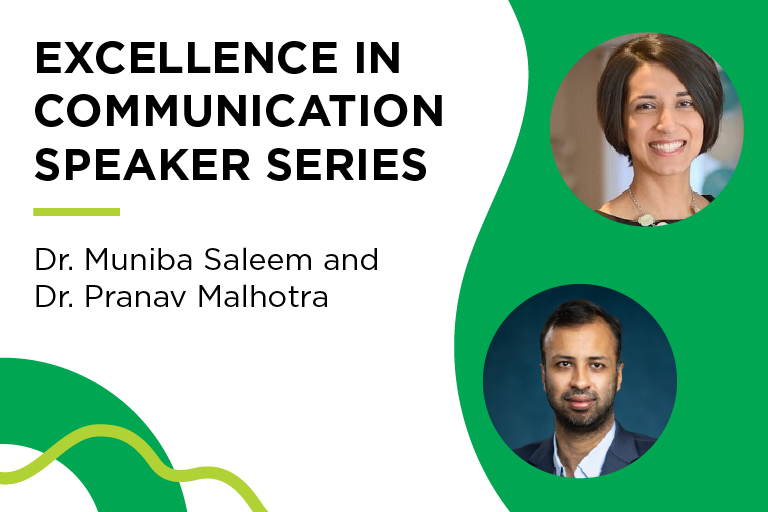Two communication scholars presented their research on the effects of social and mainstream media on marginalized and international groups during the 4th annual Michigan State University Excellence in Communication Scholarship Speaker Series on March 8.
The Department of Communication hosted Muniba Saleem, Ph.D., Associate Professor at the University of California Santa Barbara and Pranav Malhotra, Ph.D., Assistant Professor at the University of Michigan Department of Communication and Media.
“This speaker series features cutting edge social scientific research on diversity, equity and inclusion topics,” said Dr. Elizabeth Dorrance Hall, director of the Family Communication and Relationships Lab. “Both scholars’ work utilizes communication theory to better understand the relationship between media and the experiences of marginalized groups and / or non-Western populations.”
Media’s Influence on Intergroup Relations
Dr. Saleem led the series with her lecture, “Media’s Influence on Intergroup Relations.” Using social scientific methods, Saleem studies how the media represents marginalized groups in a context of violence, and the detrimental effects that policies enacted towards those groups have on their self-identity.
For example, Saleem noted that most Americans have little to no direct experience with Muslims in their daily lives, and therefore rely on the media for information. She said media narratives of Muslims tend to drive how they’re perceived in the larger society.
“Depicting a group in an aggressive manner is likely to activate aggressive perceptions of that group,” Saleem said. “So, thinking that members of that group are hostile…increases the likelihood of aggressive behaviors against them, including support for public policies that are harming members of those groups.”
Saleem also explained that negative media stereotypes harm minority self-esteem.
“(They have) feelings such as anger, embarrassment, shame…especially when watching content along with majority members,” she said. “So, (it’s) like feeling kind of embarrassed that this is how my group is being depicted. It’s also been associated with psychological stress and anxiety.”
Saleem noted she conducted a recent content analysis that revealed similar findings are relevant to many other racial and ethnic minority groups.
She concluded that having more variation and nuances in media depictions of racial, ethnic and religious minorities would have a powerful effect in reducing negative evaluations of those groups.
“So, it's not necessarily the media that's the problem, it's the content within it that’s really driving our attitudes,” Saleem said.
Internationalization in Communication Research: Experiences Studying Social and Mobile Media Across the Globe
In the second lecture of the series, Dr. Pranav Malhotra focused on interpersonal relationships in his lecture, “Internationalization in Communication Research: Experiences Studying Social and Mobile Media Across the Globe.”
“Very broadly, I focus on how people engage with information and each other through social and mobile media,” Malhotra said. “What I'm really interested in is the relationship between those two aspects. How do our interpersonal relationships impact the ways in which we engage with and evaluate the credibility of information?”
As an example, Malhotra analyzed a Gates Foundation video promoting greater accessibility of mobile phones for the world’s poorest women. Malhotra said the messaging suggests that giving that group a phone begins to break down patriarchal norms and creates a sense of agency and empowerment.
However, Malhotra explains, studies he conducted among Indian women painted a different reality.
“What we found on the ground was that access to a mobile phone does not automatically result in empowerment or even disempowerment,” he said. “What it typically does for marginalized and poor women is that it makes their everyday lives slightly easier. It facilitates coordination. It helps them feel a little safer. It helps them feel a little more connected to their family, especially when they're outside of the house and are working. So, all of those things are great, but it certainly does not come close to challenging existing patriarchal power structures. These women still often lack power and agency within their own families, especially compared to their male counterparts.”
Malhotra used a second example to illustrate how family dynamics in India intersect with social media. He noted the popularity of the messaging platform WhatsApp, describing it as the primary means by which many Indians socially engage with the Internet. Malhotra said WhatsApp has been a vehicle through which misinformation about topics like politics and COVID-19 has been disseminated…particularly in family group chats.
“As I was personally seeing these chats become a real hotbed of misinformation in my own family, I started to see a lot of people, including my friends and family, discuss this issue,” Malhotra said. “And when they did, they talked about the difficulty of correcting misinformation in these chats, especially when misinformation is shared by an older relative.
So, we were interested in the role of ‘face politeness’ and how young Indians react when their older relatives share misinformation, particularly given the salience of Indian cultural norms surrounding showing respect and deference to elders. You’re not supposed to talk back.”
Each lecture demonstrated the importance of considering culture when interpreting the impact of traditional and social media on various groups.
By: Kevin Lavery
